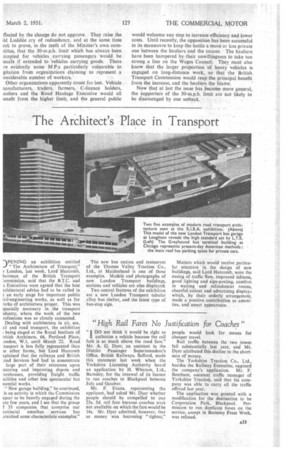The Arehitect's Place in Transport
Page 59

If you've noticed an error in this article please click here to report it so we can fix it.
-)PENING an exhibition entitled
"The Architecture of Transport," 1 London, last week, Lord Hurcomb, hairmart of the British Transport 'ommission, said that the B.T.C. and s Executives were agreed that the best rchitectural advice had to be called in t an early stage for important public ivil-engineering works, as well as for
■ orks of architecture proper. This was specially necessary in the transport idustry, where the work of the two rofessions was so closely connected. Dealing with architecture in air, sea, iii and road transport, the exhibition being staged at the Royal Institute of .ritish Architects, 66, Portland Place, ondon, W.1, until March 22. Road .ansport is less fully represented than se other forms, but Lord Hurcomb xplained that the railways and British .oad Services had had to concentrate large part of their re-sources upon !storing and improving depots and urehouses, providing freight traffic icilities and other less spectacular but ssential works.
"New garage building," he continued, is an activity in which the Commission xpect to be heavily engaged during the ext few years, and I see that the group f 33 companies that comprise our rovincial omnibus services has Jrnished some characteristic examples."
The new bus station and restaurant of the Thames Valley Traction Co., Ltd., at Maidenhead is one of these examples. Models and photographs of new London Transport buildings, stations and vehicles are also displayed.
Two central features of the exhibition arc a new London Transport tubular alloy bus shelter, and the latest type of bus-stop sign. Matters which would receive particular attention in the design of new buildings, said Lord Hurcomb, were the easing of traffic flow, improved tidiness, good lighting and sign-posting, comfort in waiting and refreshment rooms, cheerful colour and advertising displays which, by their orderly arrangement, made a positive contribution to amenities, and smart appearance.




























































































